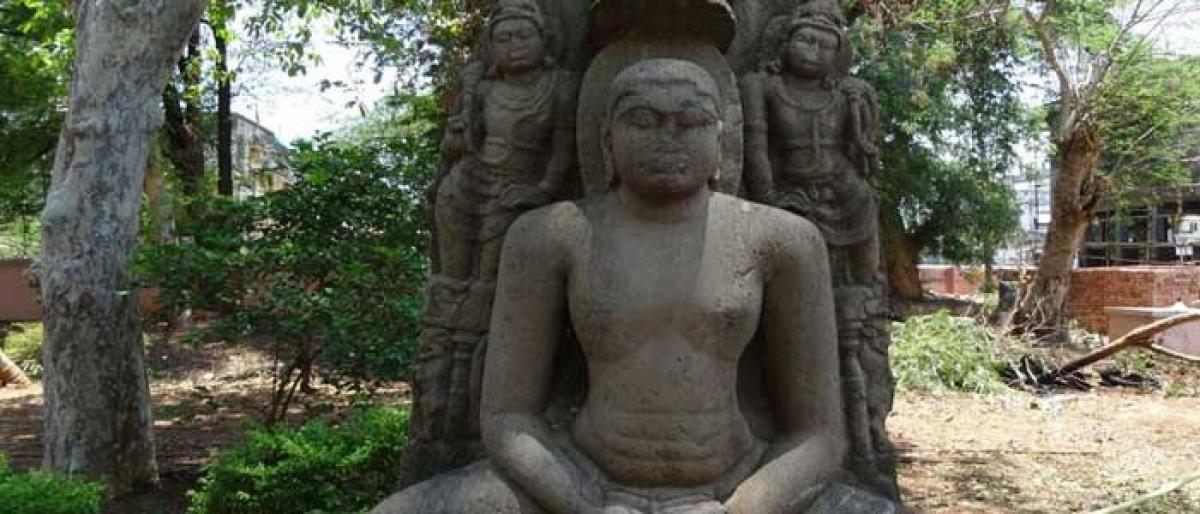Live
- Complete bridge at earliest: BJP
- 4 held for attacking man, causing fatality
- KTR to roll out ‘Gurukula Baata’ from Nov November 30
- Preliminary answer key released for scholarship exam
- Men’s Junior Asia Cup hockey: India thrash Thailand 11-0
- Syed Modi International: Sindhu, Lakshya storm into second round
- Edn dept launches investigation into food poisoning cases at ZPHS
- World Chess Championship: Gukesh outplays Liren in Rd3 for first win
- HC serious over food poisoning cases, orders action against erring babus
- Bhatti dubs KTR a ‘nervous wreck’, rails against his rants
Just In

Apart from the Buddhist relics that littered on the Indra Kiladri hill – AkkannaMadanna Caves, Sitanagaram Caves, Mogalrajpuram and Undavalli Caves are datable to the early Centuries of Christian era.
Relics from old time prove that Vijayawada was an abode to Jain tradition
Apart from the Buddhist relics that littered on the Indra Kiladri hill – AkkannaMadanna Caves, Sitanagaram Caves, Mogalrajpuram and Undavalli Caves are datable to the early Centuries of Christian era.
It is interesting to note that Vijayawada (Bezwada) was a strong hold for Jainism too. Inscriptions reveal that there was a Jain monastery called NadumbiBasadi, which was supported by the munificence of the queen of the KubjaVishnuvardhana, the founder of the Eastern (Vengi) Chalukyan Dynasty.
When Pulakesin II of the BadamiChalukyan lineage captured the Eastern tracts of Andhradesa such as Vengi, Pithapura and region further down of the River Krishna. In 621 AD, he installed his younger brother KubjaVishnuvardhana also titled as Vishamasiddhi as the ruler of Vengi. His queen Ayanamahadevi donated a village Musinikonda to a Jain temple in a monastery called NadumbiBasadi (the term Basadi derived from Vasati [accommodation] later called as Basti [Township] in modern days) of Bezawada in the year 627 AD.
NadumbiBasadi, the first dated Jain establishment in coastal Andhra, was situated near Jammidoddi area or on the left side of the Kanakadurga Temple locally known as Mallikarjuna Hill, according to Sripada Krishna Murthy, author of ‘Jain Vestiges in Andhra’. This Jain settlement belongs to the Swetambaras, as only Swetambarasfavoured women to receive Diksha to help them to work up for emancipation.
This is also attested by the incidents occurred at Badami. After some time in history, the village Musinikonda got out of the enjoyment of the NadumbiBasadi of Bezawada, due to some reason or the other exactly after one year of its establishment. A Jain preceptor called Kalibhadracharya, known for his knowledge in the Jain texts called Angas.
He brought to the notice of the King Vishnuvardhana-III (718-755 AD) the fact of the occupation of Musinikonda by others. The king promptly donated the village again to Kalibhadracharya, through an inscription, for arranging the regular worship of the Arhats.
The inscription further mentions that this pontiff had another name Devanandi, which indicates that he was originally a member of the Devagana and he was rendering his services to the acharyas of the Nandigana, he came to be a Devanandi and was enjoined upon to conduct regular worship, consisting of “seval” ceremonies like Garbha, Janma, Diksha, Abhisheka to the Arhats installed in the shrines and the Jinendrotsava performed on Kurthika Pournami days.
This Musinikonda inscription of Vishnuvardhana-III bears another significance that the Jains used Vikrama era (but not the Salivahana Saka year) which commenced in 57 BC. The inscription is dated Vikrama Saka year 684 and after subtraction of 57 years, the date of the record comes to 627 AD.
It is also a known fact that a good number Jain images now housed in the premises of the Victoria Jubilee Museum Vijayawada and they were collected from Mallikarjuna Hill. Jammidoddi Centre and Konakondla, a village lying five kilometers south wards Vijayawada associated with famous Jain teacher Kundakundacharya. All the above proves beyond doubt that Vijayawada was a stronghold for Jains too about 1,400 years ago.
By: Dr E Sivanagi Reddy- Sthapati
The writer is Chief Executive Officer at the Cultural Centre of Vijayawada and Amaravati.

© 2024 Hyderabad Media House Limited/The Hans India. All rights reserved. Powered by hocalwire.com







